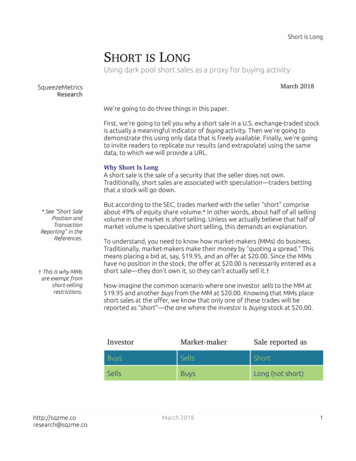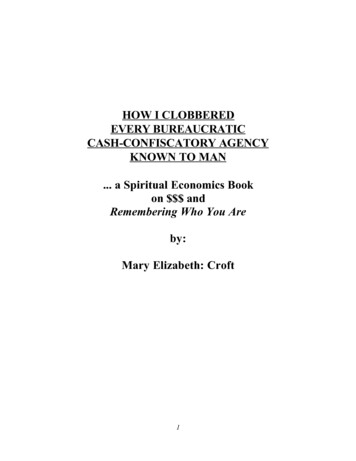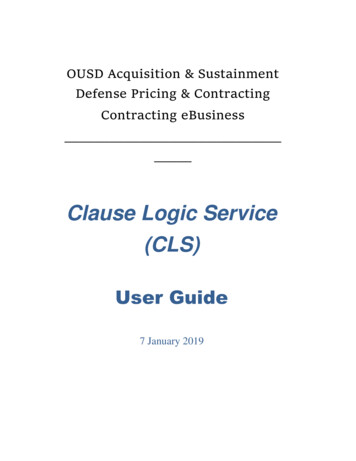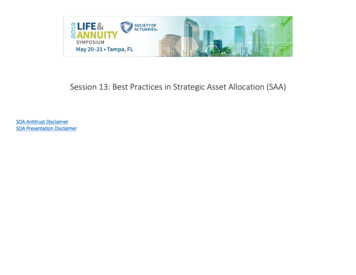
Transcription
Gamma ExposureDisclaimerThe information contained in these documents is con5dential, privileged and only for theinformation of the intended recipient and may not be used, published, or redistributedwithout the prior written consent of Prior Analytics LLC. The opinions expressed are in goodfaith and while every care has been taken in preparing these documents, Prior Analytics LLCmakes no representations and gives no warranties of whatever nature in respect of thesedocuments, including but not limited to the accuracy or completeness of any information,facts and/or opinions contained therein. Prior Analytics LLC, its subsidiaries, the directors,employees and agents cannot be held liable for the use of and reliance of the opinions,estimates, forecasts and 5ndings in these documents.http://sqzme.cosales@sqzme.coDecember 20171
Gamma ExposureGamma Exposure (GEX) Quantifying hedge rebalancing in SPX optionsSqueezeMetricsResearchMarch 2016Revised December 2017A survey of academic literature and the methods of market practitionerssuggests that the relationship between the equity option market and itsunderlying stocks is still very poorly understood.Historically, the published research on the eQect of equity options onunderlying prices has been limited to theorizing about the eQects of optionintroduction and expiration. Meanwhile, practitioners refer almostexclusively to the volatility and variance 5gures implied by the quotes of onlya small strip of strike prices, interpolated across two near-term contracts.Since few have even acknowledged the pervasive impact of existing optionson their underlying stocks, none have put forward a pragmatic model forpredicting the day-to-day impact of those options. Gamma Exposure (GEX) is the 5rst attempt at such a model.An IllustrationThe S&P 500 Index (SPX) has a large and deeply liquid market for cash-settledoptions. The commonly cited CBOE Volatility Index (VIX) is derived fromthese options. As a calculation of 30-day option-implied variance, VIX uses aselection of quoted prices to derive what can be considered, put simply, anestimate of how much the S&P 500 will move in the future.* CBOE(see References)As you might expect, VIX is eQective at predicting 30-day future realizedvolatility―the CBOE places the correlation at 0.75. But the VIX is morestrongly correlated (0.85) to the realized volatility of the previous month.*This calls into question whether VIX can be used to forecast SPX variance.In that vein, the VIX clearly fails to generate suitably distinguishable futurestock return distributions at its lower readings. The 1-day standard deviationof SPX returns following the lowest quartile of spot VIX closes (0.51%) is nota great deal diQerent from that of the second-lowest quartile (0.66%). A VIXof 12 means about the same as 15 when it comes to predicting variance.** Like low VIX,high GEX predictslow volatility.http://sqzme.cosales@sqzme.coWhen instead we compare the highest and second-highest** quartiles of GEXto subsequent SPX variance, the 1-day standard deviations are 0.55% and0.85%, respectively. On an index trading at 2000, the diQerence between0.66% and 0.85% is a 4-point diQerence in range every day.December 20172
Gamma Exposurehttp://sqzme.cosales@sqzme.coDecember 20173
Gamma ExposureWe believe that the greater granularity of the GEX distributions suggeststhat there is some element of market volatility that is simply not able to becaptured by the VIX model, or indeed any other variance metric based onquoted option prices. Rather than prices, GEX concerns itself with thequantity and characteristics of all existing option contracts at all strikes, andat all expirations―and the market participants who trade them.Dynamic HedgingThe predictive power of GEX is essentially driven by the necessity of optiondealers' (market makers') re-hedging activities. In order to limit risk andrealize pro5t, an option market-maker must limit his exposure to deltas.* It is easier tospeak of dynamichedging in terms ofshares, but SPXoptions have nounderlying shares,and can be hedgedwith futures.If, e.g., a market-maker sells a single, 20-delta put contract to an investor, hemust then short-sell approximately 20 shares of the underlying stock* inorder to (temporarily) neutralize the convexity eQect of the option's gainsand losses. Since the convexity itself cannot be hedged away, the marketmaker must commit to re-hedging the option to its new delta whenever theunderlying price changes enough to justify action.If in one case the price of the underlying falls and the put delta rises from 20to 50, the market-maker will be compelled to short-sell an additional 30shares of the underlying to stay delta-neutral. If instead the underlying risesand the put delta falls to 0, the market-maker would buy back the previouslyshorted shares. Thus, a market-maker is essentially committed to apredictable and quanti5able regimen of buying and selling stock.Four AssumptionsThe size and liquidity of the equity option market is what makes it possibleto glean predictive information from the impact of hedging activity, but italso introduces some challenges. With a few assumptions, we attempt toovercome those challenges:1. All traded options are facilitated by delta-hedgers. This is to say that everyoption contract is either bought by, or sold by, a market participant whosebusiness is to pro5tably manage a book of options.2. Call options are sold by investors; bought by market-makers. It is dihcult todetermine the “direction” of a trade in an ultra-liquid market, as in the caseof SPX options. A vast majority will trade at the midpoint of the bid and ask.It is apparent from an analysis of skew, open interest at strike, and(circularly) the eQects of GEX, however, that the practice of call overwriting(and stock collaring) drives the market for calls.3. Put options are bought by investors; sold by market-makers. As with calls,puts are primarily used by investors who are already exposed to theunderlying market, and who are looking to modify the return pro5le of theirportfolio by using options. The “protective put” commands a premium forhttp://sqzme.cosales@sqzme.coDecember 20174
Gamma Exposurethis reason, thus inkuencing the apparent vertical skew of index options.4. Market-makers hedge precisely to the option delta. If market-makers hedgedtheir deltas every time an option's delta changed, they would be tradingincessantly. In reality, market-makers utilize “hedging bands” to balance thetwin challenges of hedging costs and delta risk. Since it is not feasible togauge the breadth of every market-maker's hedging band, we simply use thedelta of the option.With these assumptions we can compute GEX.ComputationThe gamma of an option is the 5rst derivative of its delta, expressed as therate of change of delta per 1-point move in the underlying. To calculate theGEX of an option, we need to determine the share impact of that potentialchange in delta on a market-maker's book.Thus, if the gamma of a single 50-delta call option is 10, we can assume thata market-maker will re-hedge that option to either 40 or 60 delta in theevent of any 1 point move in the underlying. In either case, the marketmaker will need to trade 10 shares. E.g., if the underlying moves up 1 pointand the new delta is 60, the market-maker will short-sell 10 shares. If theunderlying moves down 1 point and the new delta is 40, the market-makerwill buy back 10 shares.In the case of a put option (assumed to be held short by a market-maker), themechanism is the same, whereby re-hedging involves selling shares as deltarises and buying as delta falls.* When computingfor SPX, wedenominate GEX indollars.To calculate the GEX (in shares*) of all call options at a particular strike pricein a contract:GEX Г · OI · 100Where Г is the option's gamma, OI is the open interest in the particularoption strike, and 100 is the adjustment from option contracts to shares ofthe underlying.In the case of put options:GEX Г · OI · (-100)The share adjustment is negative here because for market-makers, wherecalls represent long gamma, puts represent short gamma.The GEX of a stock (or index) is the summation of GEX at every strike price inevery available contract.http://sqzme.cosales@sqzme.coDecember 20175
Gamma ExposureMarket ImpactUsing the above computations, a GEX 5gure that is positive implies thatoption market-makers will hedge their positions in a fashion that stikesvolatility (buying into lows, selling into highs). A GEX 5gure that is negativeimplies the opposite (selling into lows, buying into highs), thus magnifyingmarket volatility.A corollary is that a GEX 5gure approaching zero will allow the market tomove naturally and without any particular interference from market-makers're-hedging activities.The 5gure below, plotting SPX returns against SPX options' prior day GammaExposure, bears this out.Note the exponential increase in volatility as GEX trends below zero, and thegradual tightening of the distribution as GEX rises.It would be dihcult to come up with an alternate explanation for thisbehavior.http://sqzme.cosales@sqzme.coDecember 20176
Gamma ExposureBeyond SPXAs implied by its computation, GEX can be used to forecast returndistributions in any optionable equity with enough open interest toinkuence prices. Aggregating GEX data across a basket of stocks or sectors inorder to gauge potential risk or return potential is another plausible usecase.An investment process that selected potential investments from thecomponents of the S&P 500 by screening for a GEX near zero yielded excessreturns.All of the above are subjects for further investigation.ConclusionIf investors continue to look toward the option market for alpha signals andrisk assessments, they would do well to consider Gamma Exposure as asmarter alternative to price-derived volatility and variance estimates.The key de5ciency in using option prices to gauge future volatility is that notwo market-makers' books are the same, and a tight spread from any onemarket-maker completely obscures the risk appetite of every other. Thisproblem is readily ameliorated by computing the GEX of options known tobe in circulation and deriving projected return distributions from thehistorical market impact of those contracts.And so, when―in light of the evidence―investors eventually acknowledgethat the option market does have a truly pervasive, day-to-day impact on thepaths and volatilities of stock prices, we think that it is a natural next step toconsider GEX an essential addition to the equity investment process.http://sqzme.cosales@sqzme.coDecember 20177
Gamma ExposureReferencesAvellaneda, Marco and Michael D. Lipkin, 2003, A market-induced mechanism for stock pinning.Quantitative Finance 3, 417–425.Chicago Board Options Exchange, 1976, Analysis of volume and price patterns in stocks underlyingCBOE options from December 30, 1974 to April 30, 1975, Chicago Board Options Exchange.CBOE, CBOE, https://www.cboe.com/micro/vix/vixwhite.pdfFrey, R. and A. Stremme, 1997, Market volatility and feedback eQects from dynamic hedging,Mathematical Finance 7, No. 4, 351–374.Pearson, Neil D. and Poteshman, Allen M. and White, Joshua S., Does Option Trading Have a PervasiveImpact on Underlying Stock Prices? (February 23, 2007). AFA 2008 New Orleans Meetings Paper.Available at SSRN: https://ssrn.com/abstract 970592 or http://dx.doi.org/10.2139/ssrn.970592Sorescu, S. M., 2000, The eQect of options on stock prices: 1973 to 1995, Journal of Finance 55, 487–514.http://sqzme.cosales@sqzme.coDecember 20178
predicting the day-to-day impact of those options. Gamma Exposure (GEX) is the 5rst attempt at such a model. An Illustration The S&P 500 Index (SPX) has a large and deeply liquid market for cash-settled options. The commonly cited CBOE Volatility Index (VIX) is derived from these options. As a calculation of 30-day option-implied variance .










